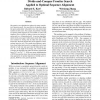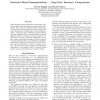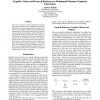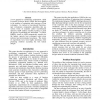AAAI
2000
14 years 24 days ago
2000
As every user has his own idiosyncrasies and preferences, an interface that is honed for one user may be problematic for another. To accommodate a diverse range of users, many com...
AAAI
2000
14 years 24 days ago
2000
We present a new algorithm that reduces the space complexity of heuristic search. It is most effective for problem spaces that grow polynomially with problem size, but contain lar...
AAAI
2000
14 years 24 days ago
2000
We shed light on the connections between different approaches to constraint satisfaction by showing that the main consistency concepts used to derive tractability results for cons...
AAAI
2000
14 years 24 days ago
2000
Selecting the right word translation among several options in the lexicon is a core problem for machine translation. We present a novel approach to this problem that can be traine...
AAAI
2000
14 years 24 days ago
2000
When humans produce summaries of documents, they do not simply extract sentences and concatenate them. Rather, they create new sentences that are grammatical, that cohere with one...
AAAI
2000
14 years 24 days ago
2000
We discuss the problem of generating text that preserves certain ambiguities, a capability that is useful in applications such as machine translation. We show that it is relativel...
AAAI
2000
14 years 24 days ago
2000
We present an approach to building a verb lexicon compatible with WordNet but with explicitly stated syntactic and semantic information, using Levin verb classes to systematically...
AAAI
2000
14 years 24 days ago
2000
Developing tools that allow non-programmers to enter knowledge has been an ongoing challenge for AI. In recent years researchers have investigated a variety ofpromising approaches...
AAAI
2000
14 years 24 days ago
2000
We analyze a corpus of referring expressions collected from user interactions with a multimodal travel guide application. The analysis suggests that, in dramatic contrast to norma...
AAAI
2000
14 years 24 days ago
2000
A new approach to evolutionary computation, called Learnable Evolution Model (LEM), has been applied to the problem of optimizing tube structures of heat exchangers. In contrast t...




